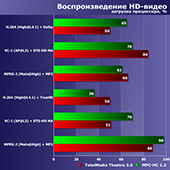
While testing the new AMD Ryzen 5 5600G APU and some other AMD and Intel hexa-core processors recently, we limited ourselves to using the integrated GPU in all participants. The reason is clear – it is this mode of operation that is the main and most important for APUs: they are purchased first of all when they plan to do without a discrete video card. But some moments with this approach remain behind the scenes. In particular, we cannot compare performance with “clean” AMD processors on Zen2 and Zen3 – precisely because of their purity . And it needs to be done. In addition, a discrete video card may eventually appear in an APU-based system – if, for example, the power of the integrated video core is insufficient. This is especially true at a time like now – when the prices of video cards are pushing for the use of integrated graphics, at least as a temporary solution: just trample on before normalization. Moreover, solutions based on Zen3 have their own specifics. The AMD Ryzen 5 5600X is a great processor – but its MSRP is $299, which hasn’t dropped since launch (especially since real prices were much higher in the early months due to shortages). And until recently, this was the cheapest offer on the new AMD microarchitecture. And the Ryzen 5 5600G received a recommended price of $ 259 – much cheaper. Yes, of course, in this case we lose support for PCIe 4.0, and performance will have to “move” – but it’s just important to understand: by how much. Moreover, we repeat, the situation on the video card market generally pushes the buyer towards this decision when assembling a new system from scratch. When upgrading, some video card may already be available – and, quite possibly, much more powerful than the built-in one, but this difference in recommended prices still remains. It is the 5600G that is the cheapest six-core Zen3, and the cheapest Zen3, in principle, risks becoming the Ryzen 3 5300G for a long time. Yes – four cores are no longer fashionable, but often quite enough. Moreover, in the case of a modern architecture – that in “pure” AMD processors it starts exclusively with six cores, which by definition is more expensive.
However, we don’t have a 5300G yet – and four cores are really not fashionable . There are different six-core models, so it’s time to test such models again. Only already a little differently than in the previous article – for better coverage of issues that were previously left behind the scenes.
Test participants
| AMD Ryzen 5 5600G | AMD Ryzen 5 5600X | |
|---|---|---|
| Kernel name | Cezanne | Vermeer |
| Production technology | 7 nm | 7/12 nm |
| Core frequency, GHz | 3.9/4.4 | 3.7/4.6 |
| Number of cores/threads | 6/12 | 6/12 |
| L1 cache (total), I/D, KB | 192/192 | 192/192 |
| L2 cache, KB | 6×512 | 6×512 |
| L3 cache, MiB | sixteen | 32 |
| RAM | 2×DDR4-3200 | 2×DDR4-3200 |
| TDP, W | 65 | 65 |
| Number of PCIe lanes | 20 (3.0) | 20 (4.0) |
| Integrated GPU | Radeon | No |
The main pair of participants is such, because when using a discrete video card, a choice appears between these models. In both cases, six Zen3 cores – but other parameters differ. First of all, the different capacity of the third level cache is striking – and different versions of PCIe: this is the fee for the built-in GPU. But you can use it right away, and buy a video card later – if when the prices become more interesting.
| AMD Ryzen 5 2600 | AMD Ryzen 5 3600 | AMD Ryzen 5 Pro 4650G | |
|---|---|---|---|
| Kernel name | Pinnacle Ridge | matisse | Renoir |
| Production technology | 12 nm | 7/12 nm | 7 nm |
| Core frequency, GHz | 3.4/3.9 | 3.6/4.2 | 3.7/4.2 |
| Number of cores/threads | 6/12 | 6/12 | 6/12 |
| L1 cache (total), I/D, KB | 384/192 | 192/192 | 192/192 |
| L2 cache, KB | 6×512 | 6×512 | 6×512 |
| L3 cache, MiB | sixteen | 32 | eight |
| RAM | 2×DDR4-2933 | 2×DDR4-3200 | 2×DDR4-3200 |
| TDP, W | 65 | 65 | 65 |
| Number of PCIe lanes | 20 (3.0) | 20 (4.0) | 20 (3.0) |
| Integrated GPU | No | No | Radeon |
But, since we are talking about prices, we need to see what else six- core is inexpensively offered on the market. First of all, previous AMD models are of interest – for example, the same Ryzen 5 4650G can be purchased cheaper, but it can also do without a discrete for some time. The Ryzen 5 3600 is even cheaper (we decided to use it over the 3600X because the performance is very close, but the prices are not; and today we are more interested in them) is one of the rightfully popular models. However, the old 2600 is still interesting to many for the same reason. Even as a new purchase – after all, there are also six cores, but it costs some pennies. And on a budget motherboard, none of the built-in capabilities are lost – unlike new models, where the built-in USB3 Gen2 and PCIe 4.0, together with many popular chipsets, will still turn into USB3 Gen1 and PCIe 3.0. But is it worth saving so much? The question is open. And isn’t it time to think about upgrading for many owners of such processors – too. Especially if the motherboard supports the installation of Zen3, or at least Zen2 – after all, the Ryzen 5 2600 is still a liquid processor. However, you can sell it together with the board – especially if it’s something four years ago: its capabilities may no longer be enough (for example, even the top models on the X370 of the first wave without tricks support the installation of only one fast SSD and are officially incompatible with Zen3). In a word, such a base today will not hurt.
| Intel Core i5-9400F | Intel Core i5-10400 | Intel Core i5-11400F | |
|---|---|---|---|
| Kernel name | coffee lake | comet lake | rock lake |
| Production technology | 14 nm | 14 nm | 14 nm |
| Core frequency, GHz | 2.9/4.1 | 2.9/4.3 | 2.6/4.4 |
| Number of cores/threads | 6/6 | 6/12 | 6/12 |
| L1 cache (total), I/D, KB | 192/192 | 192/192 | 192/288 |
| L2 cache, KB | 6×256 | 6×256 | 6×512 |
| L3 cache, MiB | nine | 12 | 12 |
| RAM | 2×DDR4-2666 | 2×DDR4-2666 | 2×DDR4-3200 |
| TDP, W | 65 | 65 | 65 |
| Number of PCIe lanes | 16 (3.0) | 16 (3.0) | 20 (4.0) |
| Integrated GPU | No | UHD Graphics 630 | No |
Same as with Intel. Here we decided to take two younger Core i5s of the tenth and eleventh generations – adding to them a similar model of the ninth. Users of these may also already be thinking about upgrading. Which in their case is possible in two directions – either replacing the processor if it is possible to inexpensively find a Core i7 or i9 under LGA1151 (but this is poorly formalized, since it fundamentally depends on how inexpensive it is), or switching to a new AMD or Intel platform with a new processor . Moreover, when choosing a motherboard based on AMD B550 or Intel B560, it is much easier to convince yourself of the need for upgrading than with just replacing the processor. Only its performance will not be limited – there will be new interfaces. Which, perhaps, in practice are not so necessary – but as an additional argument for modernization they will fit.
Ryzen 5 2600 and Core i5-9400F, recall, 2018 processors. If we rewind a year ago, there we will get (to a first approximation) the same thing – Ryzen 5 1600/1600X and Core i5 8000 series. Three to four years is quite a long time for the upgrade itch to appear. Five is even more sufficient, only in 2016 we will find at best quad-core Skylake. And it seems to us that everyone has either already changed them – or they have finally become convinced that this is not yet required. But for those in the second group, today’s testing may also be useful. Simply because the maximum for the first version of LGA1151 is the level of Ryzen 3 3100 and Core i3-10100. And, if a year ago it was decided that the replacement of the old quad-core with almost the same architectural six-core is not needed, then this year’s proposals may change the mind somewhat. Or they may not change – postponing the upgrade for another year.
Other environments are traditional for the main line of tests – a discrete video card based on Radeon RX Vega 56, 16 GB of DDR4 memory (in all cases, the maximum official frequency for each processor), a mid-range SATA SSD.
Test Methodology

The testing methodology is described in detail in a separate article, and the results of all tests are available in a separate table in Microsoft Excel format . Directly in the articles, we use the processed results: normalized with respect to the reference system (Intel Core i5-9600K with 16 GB of memory, AMD Radeon Vega 56 video card and SATA SSD) and grouped by computer application areas. Accordingly, all diagrams related to applications have dimensionless scores – so more is always better. And starting from this year, we are finally transferring game tests to an optional status (the reasons for which are discussed in detail in the description of the test methodology), so that only specialized materials will be available for them.
iXBT Application Benchmark 2020
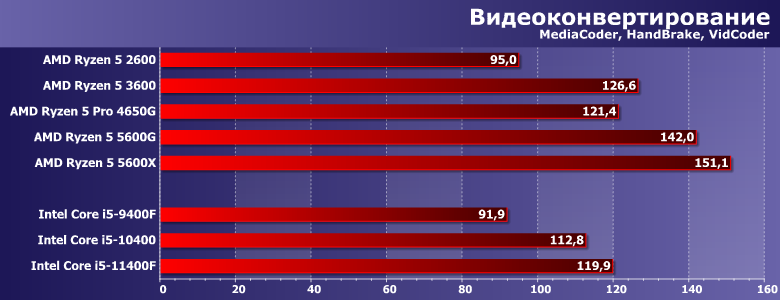
Until 2019, Ryzen needed a head start in the number of cores, or at least computation threads – without which there was no direct competition with Core. We got access to a new process technology and modernized the microarchitecture – and the roles immediately changed. In fact, the Ryzen 5 3600 set the bar so high that at first it competed even with the Core i7 – not to mention the younger Core i5. Rocket Lake got every chance to even get even with Zen2 – but the old technical process played against mass models: the typical for Core “non-K” TDP 65 W significantly limits the performance of these processors. AMD does not have such problems – so competition with Zen3 is definitely impossible for now. And even the cheapest (of the most modern six-core) Ryzen 5 5600G is already fast – which, as we have already seen, can compete with the Core i5-11600K without much effort. But with the Ryzen 5 5600X, it still can’t. Again, the miracle did not work out: just as Renoir lagged behind Matisse, so Cezanne is not quite a competitor to Vermeer. But it costs (officially) cheaper, can do without a discrete video card, and overtakes all the others (except for the half-brother in microarchitecture) without any problems. And one more interesting point – if in three years in the younger Core i5 performance has grown by 30%, then for Ryzen 5 this is almost one and a half times. But nothing surprising – one could actually expect more. After all, all that Intel managed to do was to change the microarchitecture once and stop blocking Hyper-Threading support (which turned out to be even more effective). AMD changed the microarchitecture twice – and one process technology. As you stomp – so you pop.

The nature of the load is similar – the preferences of the programs are slightly different. In particular, there is less “cache-loving”, so APUs do not suffer from L3 limitations. The 4650G turned out to be no worse than the 3600X, and, accordingly, faster than the 3600. The 5600G turned out to be incapable of such a feat, although it still turned out to be the second among all the participants. But the 11400F in this case, the limitations of the heat pack also interfere – but the redesigned FPU allows you to reach at least the level of Zen2. And the increase in productivity over three years is already closer to 40%. But AMD still has about one and a half.
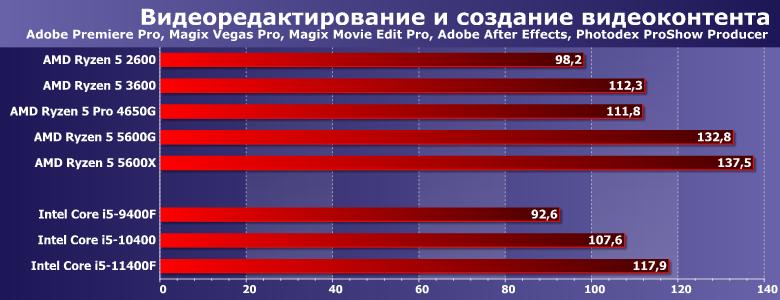
But not all applications scale as well “per processor” as the two groups above. However, the general trends are still visible to the naked eye. First, AMD has done more work over the past three to four years – and achieved better results. Secondly, Intel is hindered most of all by one thing – the technical process that has remained unchanged since 2014. Then – revolutionary and the best on the market. Three years later, still the best on the market. In general, it turned out to be so unique that it is still not outdated to a large extent – but has already ceased to be the best, and at times has begun to frankly interfere. The new 10 nm has finally been brought to mind – but in the desktop segment they are not yet used with all the consequences.

The first Ryzen in these programs had a hard time – the tactic of “throwing cores” does not work here. We changed the microarchitecture – and everything worked out right away. At first sight. On the second, the technical process also helped here, which allowed unprecedented amounts of cache memory to be stuffed into “clean” processors. Where there was no place for them, everything is much worse, and the increase in L3 in Cezanne is still not enough. Although in practice everything is not so scary – it is already not far behind the 3000th family, and can compete with Rocket Lake. However, the latter can demonstrate a comparable level of performance at lower prices, but the latter is perhaps the main problem of Zen3 in all variants. Which is much less than we would like.

One gets the feeling that the increase in L3 was in its purest form a necessary measure – without this, replacing the cores with more productive ones might not be very effective. As a result, just as Renoir lacked it, Cezanne is also lacking to the same extent (already more). But in practice, again, the measures taken are already enough to overtake “clean” processors. And with Intel, it’s a tragedy in general – improvements in the microarchitecture in a limited thermal package did not give any effect at all. Actually, there is nothing surprising in the fact that such an upgrade at Intel was delayed until the last moment – and they did not even try to use it in more mass-produced (and even more limited in consumption) laptop processors, no. Here’s a simple “turn on” HT and a small proportional increase in L3 at the time, the performance of the Core i5 increased one and a half times. But the need for this was ripe even before the advent of Zen2 – more threads in Ryzen put the Core in a very uncomfortable position initially.
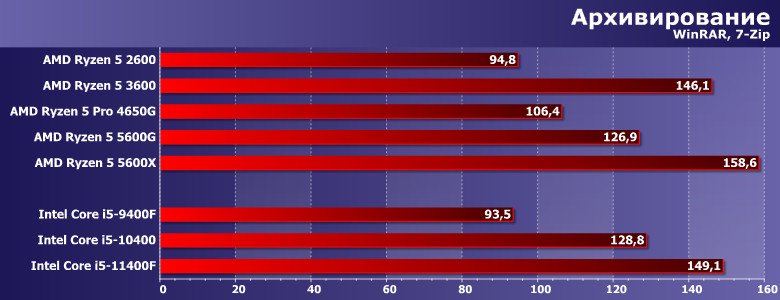
But in archivers, they still feel dry and comfortable – and the worst thing in this group is the APU. In the new generation, however, they managed to win back part of the gap from models without graphics – the increase in L3 helped. But still: Ryzen CPUs are the best, Ryzen APUs are the worst. And Zen2 is inside or Zen3 is not important. The case when the environment is more important than the cores themselves.
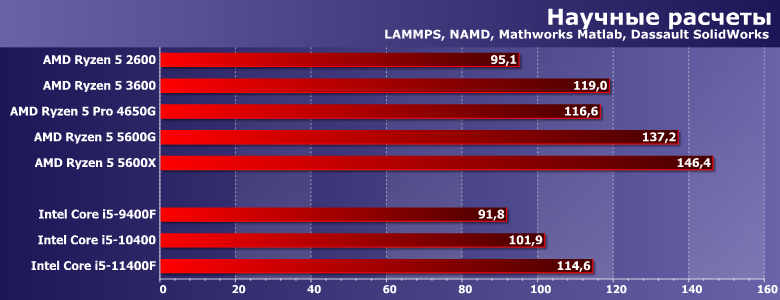
A more familiar picture. Just complementing other scenarios. So let’s go straight to the results – it is already very difficult to make a mistake with them, even if you do not look at specific numbers.

Let’s start with AMD. And, according to tradition, from the bad – it’s easy to see that the performance of the APU in general-purpose applications is lower than that of the “clean” Ryzen CPUs on the same number of similar cores. The size of the backlog at the last stage has not changed, despite the doubling of the capacity of L3 – since the new cores would not hurt even more L3. Add to this the “old” PCIe – and we understand that with the similarity of names and unification (finally!) of model numbers, these are significantly different devices. The strength of the APU is a good (by the standards of this segment) integrated graphics. But if it is not supposed to be used, then for equal money a “clean” processor is better. And now they are rather equal in retail – despite the official price list, since the opportunity to at least temporarily do without a discrete video card in our time is worth a lot in the literal sense. Therefore, in such a situation, updating the APU lineup cannot but be welcomed – we get the same + 20% performance with a generation change. Yes – from a lower base. But the ability to buy a processor with graphics faster than a “processor without graphics” in itself may be important to someone. Moreover, AMD is ready to sell such (unlike its predecessors) in large quantities. Yes, and with logical pricing – slower, but also cheaper (and it’s a pity that the invisible hand of the market corrects this).
Intel does not have a problem of choosing between smart and beautiful – but there is a serious technological one. The notorious outdated technical process – which hits the younger processor models especially hard: the traditional 65 W in this segment is simply not enough this time. You can, of course, “unclench” (or completely cancel) manually – but the effect may also be unusual for buyers of younger Core i5s: since you have to take care of the cooler, and choose a board with a powerful power system to get the maximum effect. For buyers of the top series, this is not a novelty – but here the situation is different. But cheap six-core Rocket Lake generally exist in nature (especially cheap ones, if you focus on discrete) – but Zen3 still does not. On the other hand, the role of “cheap, but not so fast” is still well played by Zen2 – so the exchange is almost equivalent. Apart from other features…
Energy consumption and energy efficiency

…because there are no economical Rocket Lakes either. At first glance, the Core i5-11400F seems to be so, but only because it was driven with an iron hand into the framework in which its predecessors were simply spacious. Driven – along the way, forcing the processor to work slower than it could. And all the same, extra 20-30 watts ran up. And if you try to remove the restrictions, then this baby flies under the same 200 watts as the older models of the line. AMD does not have such “features”. And in general – Zen3 with the same technical process has become (in all forms) more economical than Zen2. And monolithic APUs consume less power than pure processors.
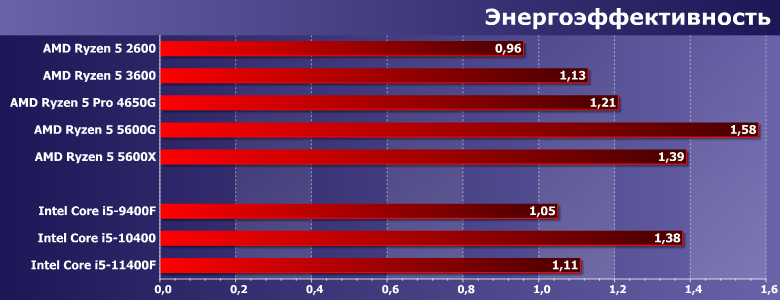
And the former leadership of Intel in energy efficiency has resolved. Although, in fairness, the company’s junior processors look better in this regard – they do not have to try to overtake direct (or even a priori stronger) competitors at any cost, and the TDP limit itself is useful for this purpose. But modern AMD processors are capable of more. Moreover, when switching to Zen3, energy efficiency increased – but Rocket Lake only reduces it. This microarchitecture is too “complex” for 14 nm – that’s why it was put off until the last minute in this form.
Games
As already mentioned in the description of the methodology, it makes no sense to keep the “classic approach” to testing gaming performance – since video cards have long been determining not only it, but also significantly affect the cost of the system, you need to “dance” exclusively from them. And from the games themselves – too: in modern conditions, fixing a game set for a long time does not make sense, since literally everything can change with the next update. But we will carry out a brief test in (albeit) relatively synthetic conditions – using a couple of games in the “processor-dependent” mode.


However, this is significant enough. Firstly, once again we admire the fairness of the claims against the first Ryzen by gamers. Secondly, once again we see the loss of APU to “clean” processors. But there are nuances – in the previous generation it was larger, which is why we did not even try to include Renoir in a large game test. It is clear that all the same, everything will be determined first of all by the video card, but if you are guided by its mandatory presence, there is nothing to buy an APU for. If only it will turn out that way – but it’s hard to plan something in advance. These processors are faster than the “old” Ryzen, but the latter are still popular due to the fact that they cost a penny (relatively). But they still couldn’t keep up with the “old” Core APUs of 2020.
But increasing L3 to 16 MB seems to be enough in some cases: in the 5000th line, the difference has been greatly reduced. Even more important is that the same 5600G can already outperform any older processors from AMD itself – and it looks advantageous against the background of Intel. It is clear that it is dangerous to make a final conclusion on just two games – but here, at least, there is something to study additionally. And considering the APU as a temporary solution has become easier – there will be no fear of losing too much in the future.
On the other hand, the 5600G is still expensive. The younger models of Intel processors are slow due to low clock speeds (which is further exacerbated by power consumption limits), but they are inexpensive. At the same time, it is clear that in quality settings closer to reality, the same 10400 (or better than 11400) will still be able to work on the entire video card in a gaming PC. And if so, why pay more?
Total
We have already written and will repeat once again that the main problems of the Ryzen 5000 family lie not at all in the technical part. Everything is just fine with it: in all its manifestations, these processors are not the best on the market at the moment in terms of the totality of characteristics. The problem is that there are few of them – and they are all (relatively) expensive. From this point of view, one cannot help but welcome the appearance of new APUs, this is an expansion of the range, moreover, with cheaper models. But the situation on the video card market played a bad joke on them: in fact, they are usually sold for more than the recommended prices. In fact, the retail price of the Ryzen 5 5600G is now the same as the Ryzen 5 5600X, which makes it a great choice when you plan to use an integrated GPU – but a bad choice when you already have a discrete graphics card (even an old one – a new one and then you can buy it) . And cheaper there are only old Ryzen models – or Intel processors. Here the situation is reversed: technically, Core has been losing the last couple of years, but this can be compensated for by the price. It is clear that performance will also be lower, but it is not always fundamental, especially since the most demanding users have long been guided by 8+ cores, leaving 4-6 to the mass buyer, and the latter pays much less attention to the numbers in benchmarks.
In general, prices are the weapon of the laggard. The last time Intel resorted to it was in the middle of the 2000s, in a similar position. The older Pentiums were sold at the price of an Athlon of a similar positioning (but higher performance), but, for example, only Intel had budget dual cores in its assortment. The release of the Core 2 Duo changed roles radically – and for a long time. But as soon as AMD began to produce good products again, the company immediately stopped playing the defender of all orphans and the poor . Especially since, generally speaking, such a role is difficult for a technology leader – retail always strives to correct a too “tasty” recommended price. Therefore, the state of affairs becomes so unstable: if Ryzen 9 unconditionally rules the ball in the segment of top desktop processors (and Ryzen Threadripper still has no one to compete with even on “old” cores), then you will have to choose a floor or two below. Paying attention not only to speed, but also to the functionality and cost of the platform (as well as its components). But in any case, Cezanne today is a very good offer. Which prevents to be excellent only the price.




